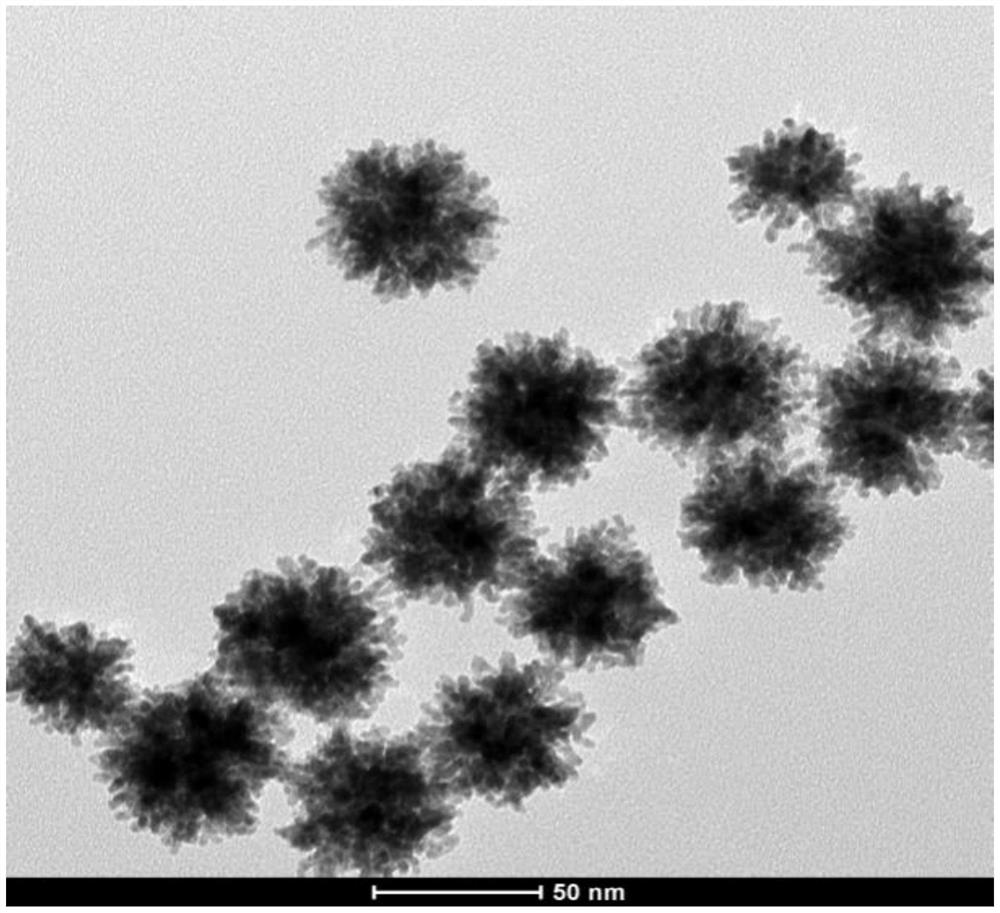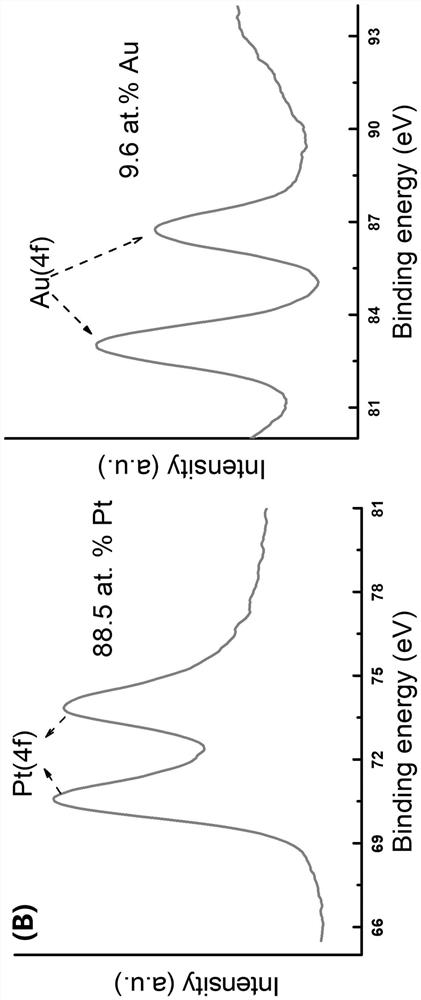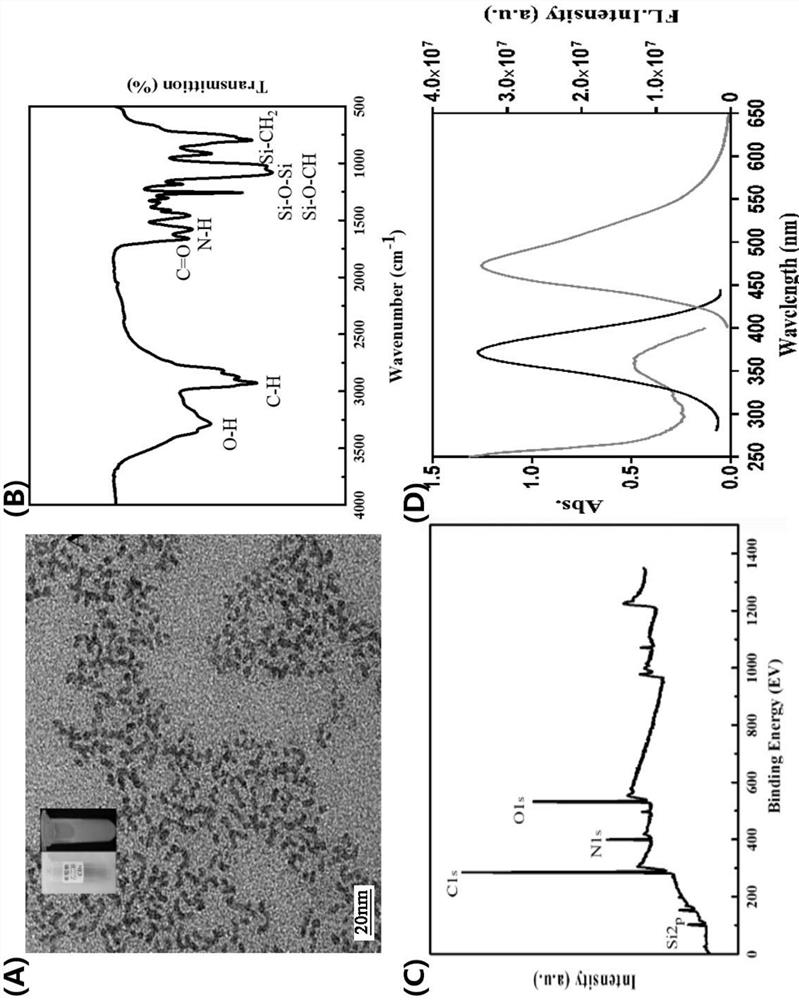A Ratiometric Fluorescence Analysis Method for Detecting Mercury Ions
An analysis method, ratiometric fluorescence technology, applied in the field of fluorescence analysis, achieves the effects of simple operation, high precision and sensitivity, and broad application prospects
- Summary
- Abstract
- Description
- Claims
- Application Information
AI Technical Summary
Problems solved by technology
Method used
Image
Examples
Embodiment 1
[0039] This embodiment provides a ratiometric fluorescence analysis method for detecting mercury ions, which specifically includes the following steps:
[0040] Step S11. Synthesis of platinum-gold nanoparticles: 0.9 mL K 2 PtCl 4 (20 mM), 0.1 mL HAuCl 4 (20mM) mixed, add 10 mg of poloxamer (Pluronic) F127, ultrasonic to dissolve it, then add 1.0 mL of ascorbic acid (100 mM) as a reducing agent, the mixed solution was ultrasonically reacted in a water bath at 30ºC for 5 hours, and the product was subjected to 10000r / Centrifuge for 20 min to separate, wash with ethanol and water repeatedly 5 times to remove residual PluronicF127, and reconstitute with 0.9 mL of water for later use.
[0041] It can be seen from Figure 1 that the prepared platinum nanoparticles are porous nanostructures with a particle size of about 50 nm, and the surface is composed of uniformly distributed Pt nanoparticles of about 5 nm.
[0042] Step S12. Synthesis of silicon-doped carbon quantum dots: tak...
Embodiment 2
[0050] This embodiment provides a ratiometric fluorescence analysis method for detecting mercury ions, which specifically includes the following steps:
[0051] Step S21. Synthesis of platinum-gold nanoparticles: 0.7 mL K 2 PtCl 4 (20 mM), 0.1 mL HAuCl 4 (20mM) mixed, add 10 mg of poloxamer (Pluronic) F127, ultrasonic to dissolve it, then add 1.0 mL of ascorbic acid (100 mM) as a reducing agent, the mixed solution was ultrasonically reacted in a water bath at 30ºC for 8 hours, and the product was subjected to 10000r / Centrifuge for 20 min to separate, wash with ethanol and water repeatedly 5 times to remove residual PluronicF127, and reconstitute with 0.9 mL of water for later use.
[0052] Step S22. Synthesis of silicon-doped carbon quantum dots: take 0.2M N-β-(aminoethyl)-γ-aminopropyltrimethoxysilane in a 100 mL three-necked flask, degas with nitrogen for 5 min , heated to 240°C, quickly added 0.05M anhydrous citric acid under vigorous stirring, and kept heating at this ...
Embodiment 3
[0056] This embodiment provides a ratiometric fluorescence analysis method for detecting mercury ions, which specifically includes the following steps:
[0057]Step S31. Synthesis of platinum-gold nanoparticles: 0.5 mL K 2 PtCl 4 (20 mM), 0.1 mL HAuCl 4 (20mM) mixed, add 10 mg of poloxamer (Pluronic) F127, ultrasonic to dissolve it, then add 1.0 mL of ascorbic acid (100 mM) as a reducing agent, the mixed solution was ultrasonically reacted in a water bath at 30ºC for 10 hours, and the product was subjected to 10000r / Centrifuge for 20 min to separate, wash with ethanol and water repeatedly 5 times to remove residual PluronicF127, and reconstitute with 0.9 mL of water for later use.
[0058] Step S32. Synthesis of silicon-doped carbon quantum dots: take 0.15M N-β-(aminoethyl)-γ-aminopropyltrimethoxysilane in a 100 mL three-necked flask, degas with nitrogen for 5 min , heated to 240°C, quickly added 0.05M anhydrous citric acid under vigorous stirring, and kept heating at this...
PUM
| Property | Measurement | Unit |
|---|---|---|
| particle diameter | aaaaa | aaaaa |
Abstract
Description
Claims
Application Information
 Login to View More
Login to View More - R&D
- Intellectual Property
- Life Sciences
- Materials
- Tech Scout
- Unparalleled Data Quality
- Higher Quality Content
- 60% Fewer Hallucinations
Browse by: Latest US Patents, China's latest patents, Technical Efficacy Thesaurus, Application Domain, Technology Topic, Popular Technical Reports.
© 2025 PatSnap. All rights reserved.Legal|Privacy policy|Modern Slavery Act Transparency Statement|Sitemap|About US| Contact US: help@patsnap.com



